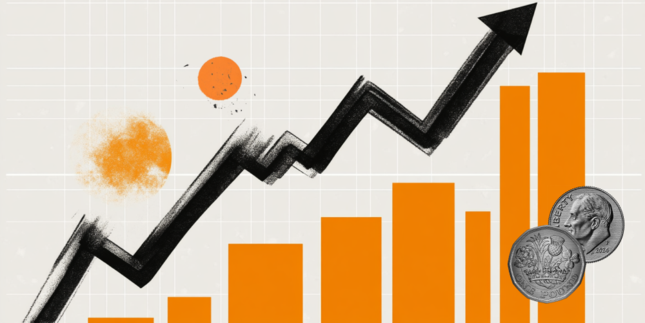US markets
The market's broken record keeps spinning, as the "Song Remains the Same" for a fourth straight day of losses. But beneath the surface, the cracks are turning into fractures. U.S. stocks continue their descent, battered by a toxic cocktail of fading consumer sentiment, inflation anxiety, and the sudden realization that Wall Street’s once-reliable defensive plays—Big Tech—are anything but bulletproof. Nvidia, the poster child of the AI boom, seemed to deliver a clean earnings beat, but the reaction told a different story. A brief 3% post-earnings rally was wiped out as the stock cratered more than 6% overnight, a clear sign that broader fears over the U.S. economy outweigh even the mightiest market leaders.
But this isn’t just about Nvidia—it’s about a market finally coming to terms with the reality that trade war risks are no longer just background noise. The dollar caught a bid as President Trump reaffirmed that the 25% tariffs on Canada and Mexico are locked in for March 4, with an additional 10% hit to Chinese imports now looming. For months, traders shrugged off the tariff narrative, convinced it was just more political posturing. But now, the rubber is meeting the road—and it’s a nasty, bearish stretch of pavement. U.S. consumer confidence is teetering on a knife’s edge, and with tariff-driven price hikes about to hit Main Street, the outlook is only getting murkier.
Zoom out, and it’s not just tariffs rattling the global economic order—this feels like a regime shift. Washington’s rapid policy pivots are colliding with Europe’s struggles to find its footing in an increasingly volatile geopolitical landscape. The real question isn’t whether growth is slowing—it’s whether we’re staring down the barrel of a major inflection point where economic momentum grinds to a halt while inflation stubbornly refuses to fade.
And here’s the kicker: markets had been banking on Trump 2.0 to deliver a fresh round of pro-business fuel—big tax cuts, aggressive deregulation, a second act of the fiscal adrenaline rush that powered his first term. But that firehose of stimulus hasn’t materialized. Investors who are positioned for another round of Trumpian economic booster shots are finding themselves stuck in the murk, forced to reassess whether the "soft landing" was just wishful thinking. If the market keeps recalibrating in this direction, the next phase won’t just be volatile—it could get downright ugly.
The balance of risks still tilts toward inflation, proving stickier than hoped, keeping the Fed boxed in and limiting aggressive rate-cutting ambitions. And that’s where things get tricky. The dreaded stagflation scenario—where inflation stays uncomfortably high while unemployment creeps up—is seeping into the market’s collective consciousness.
The reality is that when stagflation becomes the dominant narrative, there’s no safe corner in the market—just varying degrees of pain.
Forex markets
The dollar is flexing its muscles as trade war anxieties take center stage, with investors bracing for tariff turbulence to intensify. The greenback remains the ultimate safety valve, drawing haven flows as markets recalibrate for a more aggressive stance under Trump 2.0. The March 4 deadline for tariffs on Canada and Mexico is now just days away, with steel and aluminum duties set to follow on March 12—and a full-scale tariff escalation looming in April. The timeline is stacking up fast, and FX markets are taking notice.
Although bond yields have tentatively stabilized ahead of tonight’s PCE data, they remain pinned near local lows, flashing caution signals across the market. With expectations already baked in, the data is unlikely to offer much of a lifeline. The real story here isn’t just about inflation—it’s about the broader shift in sentiment. Traders are increasingly viewing the absence of a clear Trump pro-growth strategy as a serious risk factor, with trade war fallout morphing from an inflationary shock into a structural drag on economic momentum.
This shift is critical. In previous cycles, tariff-induced inflation concerns drove yields higher as markets braced for supply-chain disruptions and cost-push pressures. Now, with growth cracks forming and sentiment deteriorating, investors are recalibrating—hedging against downside risks rather than pricing in another inflationary spiral. The question now is whether this slower-moving storm evolves into a full-blown economic downturn or if markets can find a stabilizing force before sentiment deteriorates further.
The real question is: how much fiscal, tax-cut, and pro-business dry powder does the U.S. administration actually have to fire off? Markets have been banking on Trump 2.0 delivering a wave of business-friendly policies—sweeping tax cuts, aggressive deregulation, and stimulus to reignite growth—but so far, those expectations have been running ahead of reality.
SPI Asset Management provides forex, commodities, and global indices analysis, in a timely and accurate fashion on major economic trends, technical analysis, and worldwide events that impact different asset classes and investors.
Our publications are for general information purposes only. It is not investment advice or a solicitation to buy or sell securities.
Opinions are the authors — not necessarily SPI Asset Management its officers or directors. Leveraged trading is high risk and not suitable for all. Losses can exceed investments.
Recommended Content
Editors’ Picks

EUR/USD attacks 1.0800 ahead of EU inflation data
EUR/USD is battling 1.0800 in the early European session on Tuesday, undermined by the latest US Dollar bounce. Traders keenly await the EU inflation data and the US jobs survey for further impetus as US President Trump's 'reciprocal tariffs' announcement looms on Wednesday.

GBP/USD treads water above 1.2900 ahead of US data, tariffs
GBP/USD is trading on the defensive while holding above 1.2900 in Tuesday's European trading. The pair loses ground amid a modest US Dollar uptick as traders resort to repositioning in the lead-up to the top-tier US economic data releases and Wednesday's tariffs announcements.

Gold price eases from record high; bullish bias remains amid worries over Trump's tariffs
Gold price retreats slightly after touching a fresh all-time high on Tuesday as bulls pause for a breather and opt to wait for US President Donald Trump's reciprocal tariffs announcement. Adding to this, a positive tone around the Asian equity markets also acts as a headwind for the commodity amid overbought conditions on the daily chart.

PEPE could rally to double digits if it breaks above its key resistance level
Pepe memecoin approaches its descending trendline, trading around $0.000007 on Tuesday; a breakout indicates a bullish move ahead. Moreover, PEPE's long-to-short ratio supports a bullish thesis as bullish bets among the traders reach the highest over a month.

Is the US economy headed for a recession?
Leading economists say a recession is more likely than originally expected. With new tariffs set to be launched on April 2, investors and economists are growing more concerned about an economic slowdown or recession.

The Best brokers to trade EUR/USD
SPONSORED Discover the top brokers for trading EUR/USD in 2025. Our list features brokers with competitive spreads, fast execution, and powerful platforms. Whether you're a beginner or an expert, find the right partner to navigate the dynamic Forex market.